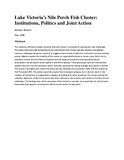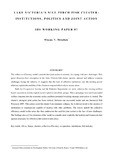| dc.description.abstract | The collective efficiency model contends that joint action is essential for coping with new challenges. This paper discusses how enterprises in the Lake Victoria fish cluster operate, interact and address common challenges facing the industry. It suggests that the lack of effective institutions and the existing power relations explain the inability of the cluster to respond effectively to recent crises. Both the Co-operative Society and the Fisheries Department are weak, whereas the existing welfare based associations merely exploit social capital in sub-ethnic groups. These groupings have not transcended welfare concerns into the economic realm, and their potential for taking strategic joint action is limited. The cluster’s strongest joint action has been vertical, between one successful trader and one Industrial Fish Processor (IFP). This action saved the cluster from imminent collapse, but it did not result in the creation of institutions or organisations capable of dealing with other problems. The results uphold the collective efficiency model in the sense that they underscore the need for joint action in the face of new challenges. The findings also call for extension of the model to consider more explicitly the institutional framework that appears necessary for effective joint action to take place. | en |


